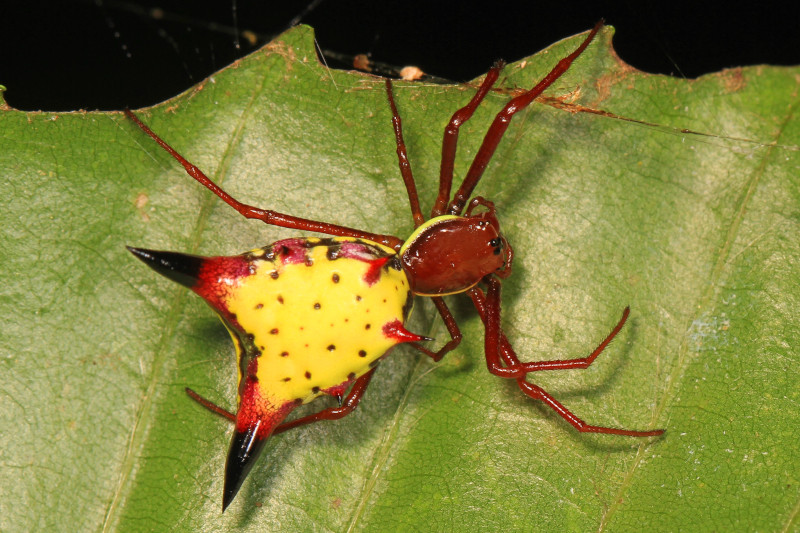
Arrow-shaped micrathena Facts
- This undeniably extraordinary Arthropod most frequently goes by the highly descriptive common name of the Arrow-shaped micrathena. Yet the marvel does have a few other general titles. These terms include Arrow-shaped Orb Weaver and simply Spiny Orb Weaver.
- Within the scientific community, however, it’s perhaps better known by its technical moniker. As such appellations go, that’s actually a relatively easy one for the layperson to pronounce. That’s because the invertebrate holds the official designation of Micrathena sagittata.
- The remarkable arachnid received that specific epithet due to the efforts of Charles Walckenaer. The highly noted French scientist accomplished the first recognition of it as a separate and distinct species. He achieved that scientifically noteworthy deed in the year 1841.
- Fortunately, the amazing Arrow-shaped micrathena appears to be maintaining a population base that’s both stable and sufficient. That pleasant state also seems to hold true across its entire range. The IUCN thus currently does not show it on its Red List of Threatened Species.
- The intriguing creature nonetheless still faces the same potential threats to its continued existence as all species on earth. Like the rest of us, most of those dangers stem from the actions of mankind. They include, among others, the perils of habitat loss and climate change.
Related Articles
Arrow-shaped micrathena Physical Description
Despite its truly distinctive appearance, the remarkable Arrow-shaped micrathena often escapes immediate notice in the wild. That’s simply due to its size. This holds true due to the fact that Nature packed all of these amazing physical traits into a comparatively small body.
In this regard, though, the interesting Arthropod does follow anevolutionary pattern typical to its many relatives around the globe. That’s displayed in the fact that it shows a certain degree of the physiological characteristic of sexual dimorphism. In its case, this manifests in pure size.
More precisely, the females of the species attain a larger average body size than that of their male counterparts. These typically measure around 0.31 – 0.39 in (0.8 – 1.0 cm) in body length. Males, however, remain significantly smaller, usually measuring about 0.16 – 0.2 in (0.4 – 0.5 cm).
The legs of both sexes additionally develop as relatively long in relation to the size of the body itself. These appendages also tend to develop as comparatively slender in nature. In color, these often display a very dark shade, usually black or dark brown, sometimes with lighter bands.
The patterns of coloring on the abdomen of the extraordinary invertebrate typically vary significantly between individuals. This does, though, typically consist of combinations of bright yellow or white with red or black markings. The unions of these colors create a striking contrast.
Yet, it’s the astonishing body shape of the unquestionably eye-catching Arrow-shaped micrathena that generally receives the most attention from observers. Its abdomen has the unique, namesake arrow-shaped design visible in these images. That symbol’s also prominently pointed at the rear.
The abdomen of the stunning Arthropod also evolved yet another impressive feature. That’s the presence of multiple relatively sharp, spine-like projections. Two prominent spines also extend sideways near the front of the abdomen, further adding to the spider’s arrowhead-like silhouette.
- Kingdom: Animalia
- Phylum: Arthropoda
- Class: Arachnida
- Order: Araneae
- Family: Araneidae
- Genus: Micrathena
- Species: M. sagittata
Arrow-shaped micrathena Distribution, Habitat, and Ecology
The fabulous Arrow-shaped micrathena evolved as indigenous to a moderately broad expanse of the surface of the earth. The full extent of that native zone of habitation might surprise some people, however. The species remains native to certain parts of North America and Central America.
In the northern part of its territorial range, the spider appears in the eastern and southeastern regions, including states like Florida, Georgia, the Carolinas, Alabama, Mississippi, and Louisiana. From there, though, it extends that territory southward into parts of the country of Mexico.
Continuing further south, the intrepid marvel of Nature and evolution also makes its home as far away as such countries as Guatemala, Honduras, and Nicaragua. It’s not currently known to entomologists if the unusual spider ever inhabited any regions outside of this present habitat range.
Like many of its relatives around the world, this product of natural selection displays decidedly clear preferences regarding its choice of habitat. It prefers wooded areas, especially deciduous and mixed forests. It’s often found in forest understories where it can easily construct its webs.
The wonder does also appear in a few other ecosystems too, though. Some of these include areas of shrublands, with areas containing sufficient vegetation to support its activities. Other settings include gardens, parks, and other semi-natural environments with ample trees and shrubs.
Typical of an orb weaver, the Arrow-shaped micrathena constructs primarily circular webs. These it usually places vertically, situated between trees or shrubs. They’re also often built at a height that maximizes the likelihood of catching flying insects, usually 3 – 6 ft (1-2 m) above the ground.
Its diet primarily consists of such locally plentifully available prey as flies, mosquitoes, and moths. The spider waits in the center of its web or hides nearby, responding quickly to vibrations caused by prey entangling in the web. It then quickly immobilizes its victim with both its silk and venom.
The mating process generally occurs in late summer to early fall. The males wisely approach females cautiously to avoid being mistaken for potential prey. Females lay eggs in a silk sac, which is often attached to vegetation. The egg sac provides protection until the many spiderlings emerge.
Baby spiders, generally called spiderlings, hatch from the egg sac and rapidly disperse by using silk threads to catch the wind and travel to new locations, a process known as ballooning. These individuals then go through several molts before reaching adulthood, typically over one season.
Species Sharing Its Range
Check out our other articles on 4 Fantastic Woody Shrubs of France, Rough-toothed Dolphin, Kaihalulu Beach, Pea Blue, Hellbender Salamander, Rose Myrtle, Lesser Purple Emperor
